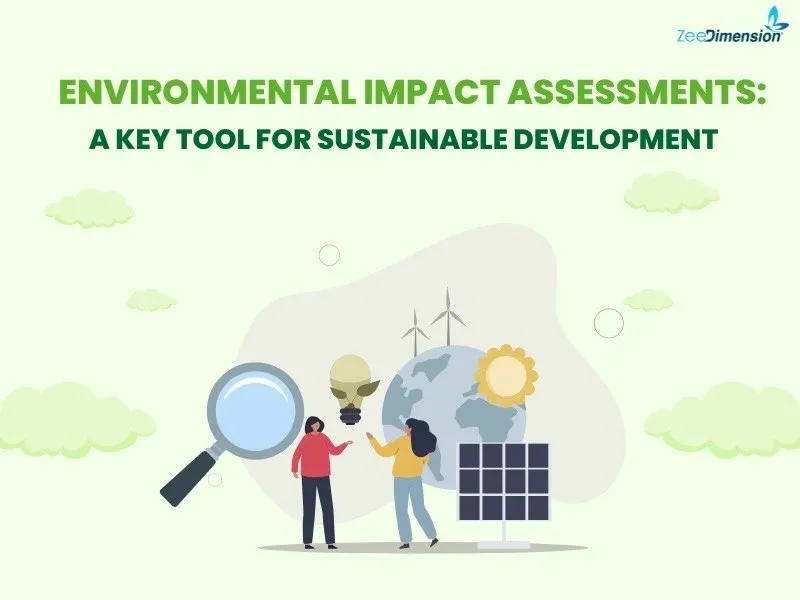
Environmental Impact Assessments (EIA) play a vital role in promoting sustainable development. They help evaluate the potential ecological consequences of a project before making decisions, ensuring a balance between industrial progress and environmental protection. In this blog, we will highlight what is an EIA? The Key Components and the Challenges in EIA Implementation.
What is an EIA?
Environmental impact assessments (EIAs), are essential instruments in pursuing sustainable development. EIAs make sure that decision-makers take into account ecological impacts in addition to economic and social aspects by methodically assessing the possible environmental effects of projects that are being proposed. By encouraging responsible development that satisfies current needs without jeopardizing the capacity of future generations to satisfy their own, this method aids in maintaining a delicate balance between environmental preservation and industrial advancement. We can identify and reduce negative consequences, encourage environmental stewardship, and facilitate sustainable, well-informed decision-making with the use of EIAs.
What are the key components of EIA?
📷
1. Screening
This first phase establishes if a proposed project necessitates a comprehensive EIA. The project’s possible effects on the environment served as the basis for the decision. A thorough EIA is performed on projects that have substantial potential effects.
2. Scoping
The main environmental concerns that must be covered in the EIA are determined during scoping. Determining the study’s scope involves looking at important environmental aspects like animal impacts, water resources, and air quality. To ensure a comprehensive review, the objective is to concentrate the evaluation on the most important problems.
3. Baseline Study
A baseline study involves collecting comprehensive data on the current environmental conditions of the project area. This data serves as a reference point to compare the state of the environment before, during, and after project implementation.
4. Impact Prediction & Evaluation
This step involves forecasting the potential environmental impacts of the project and evaluating their significance. It includes both qualitative and quantitative assessments to predict how the project will affect various environmental components. The severity, duration, and likelihood of these impacts are analyzed to understand their overall effect on the environment.
5. Mitigation Measures
Mitigation strategies are suggested to stop, lessen, or balance negative effects based on the anticipated implications. Redesigning project components, embracing new technology, and putting best practices into practice are a few examples of these actions. The goal is to increase positive results and reduce negative effects.
6. Public Consultation
Public consultation ensures that the decision-making process takes into account the opinions and worries of stakeholders, local communities, and environmental organizations.
Importance of EIAs for Sustainable Development
1. Protecting Biodiversity: To prevent habitat damage and biodiversity loss, EIAs are essential in protecting regions of high ecological significance.
2. Preventing Pollution: To detect and reduce pollution concerns and maintain a healthier environment, EIAs keep an eye on the quality of the air, water, and soil.
3. Promoting Social Equity: EIAs provide communities a voice in how development projects are decided, guaranteeing that their resources and health are taken into account and safeguarded.
Global Standards & Legal Frameworks
Numerous countries have put in place regulations that require Environmental Impact Assessments (EIAs) for significant projects to guarantee a comprehensive evaluation of potential environmental impacts before implementation. Moreover, international institutions like the World Bank and the United Nations stipulate EIAs for projects they finance, underlining the worldwide significance of environmental factors in development. For example, the European Union’s EIA Directive and the United States’ National Environmental Policy Act (NEPA) both enforce EIAs for major projects, underscoring the dedication of these areas to sustainable development and environmental conservation.
Challenges in implementing Environmental Impact Assessment (EIA) include :
1- Deficient incorporation of EIA work into critical decision-making points concerning project feasibility and related studies throughout the project life-cycle, leading to significant decisions being taken prior to the completion of EIAs.
2- Inconsistency in the identification of developments that necessitate specific environmental impact assessment studies.
3- Insufficient comprehension of the respective roles of baseline description and impact forecasting.
4- Insufficient harmonization of biophysical environmental impacts with social, economic, and health implications, contributing to challenges in Environmental Impact Assessment.
5- Generation of EIA reports that are intricate and lengthy, making them challenging for decision-makers and the public to comprehend.
6- Absence of mechanisms to ensure that EIA reports are factored into decision-making processes.
7- Weak connections between the recommendations for mitigation and monitoring outlined in environmental impact assessment reports and their implementation and operational phases.
8- Limited technical and managerial capabilities in numerous countries for executing EIAs leading to issues in conducting Environmental Impact Assessments.
In conclusion
Environmental Impact Assessments are a vital tool for balancing development with environmental preservation. Governments, businesses, and communities must collaborate to ensure EIAs lead to sustainable decisions for a greener future.







